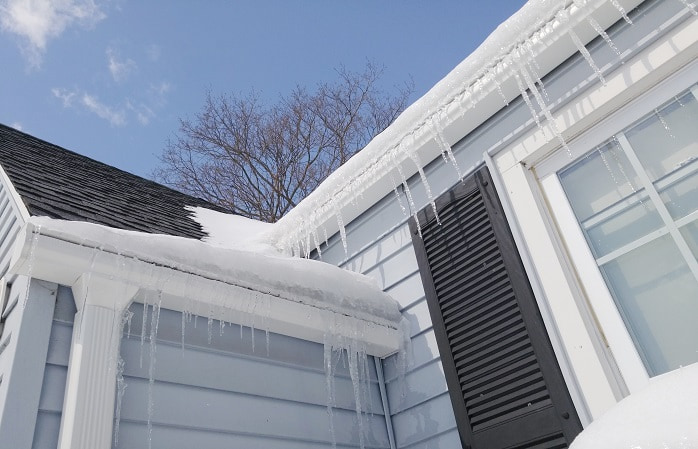
Ice dams are an unfortunate reality of Minnesota winters. As the name implies, ice dams are ridges of ice that build up at the edge of a roof, causing a dam beyond which melting snow can’t pass. The primary destructive force of ice dams comes from the water that pools behind them, which can get underneath shingles and leak into the attic.
Once it’s in the attic this water can wreak havoc, wetting insulation and promoting the growth of mold. From there it can seep through the attic floor and infiltrate the living space, causing all manner of damage to ceilings, drywall, and flooring.
What causes ice dams?
A few conditions must exist in order for ice dams to form—namely, snow on the roof and an air temperature below freezing. When these conditions are present, the primary trigger for the formation of ice dams is heated air from the living space entering the attic and warming the roof from below. (The sun can also serve as this trigger, though it is much less common.)
The melting snow then runs down the roof to the eaves, which are colder, extending beyond the frame of the house. There the water refreezes and over time builds up. This ice buildup can become quite heavy, potentially damaging gutters, downspouts, and fascia.
How can I get rid of ice dams?
The sooner an ice dam is removed, the less damage it has the potential to cause. Several actions will interrupt the melting and refreezing that feed the ice dam.
The most obvious solution is removal of snow from the roof, which deprives the ice dam of its source. For this you can use a roof rake, ideally one with wheels or bumpers to minimize the risk of damaging shingles.
Another solution is to create a break in the dam to channel water off the roof. You can easily (and safely) accomplish this by filling one leg of a pair of nylons with an ice melt product, such as calcium chloride. Drape this vertically across the ice dam. As the product melts the ice, a channel is created to usher the pooling water off the roof.
Many roofing companies offer professional ice dam steaming, which makes use of a specialized tool that uses gentle, low-pressure steam to melt the ice dam, leaving roofing materials unharmed.
Though these are all relatively immediate solutions, they are of course not permanent. Preventing the formation of ice dams in the first place is the goal.
How can I prevent ice dams?
Since the main trigger for ice dam formation is a roof warmed from heat loss into the attic from the living space below, prevention is three-pronged:
- First and foremost, the attic floor must be sufficiently insulated. This will keep heated air confined to the living space, where it belongs.
- Also crucial is the sealing of any air leaks around light fixtures, wires, pipes, etc. that penetrate the attic. Proper sealing is necessary to interrupt the flow of warm air from below, as air leaks are a major contributor to heat loss into the attic.
- Finally, proper attic ventilation is critical in order to provide air circulation underneath the roof and an escape for warm air from the attic. Optimal ventilation will consist of equal amounts of incoming and outgoing air. This is most often achieved with a combination of soffit vents and ridge vents.
A qualified roofing contractor will be able to assess how well your attic and roof meet these conditions and make any necessary recommendations to get it there.
Schedule a free inspection
We’ll meet you at your home, thoroughly assess your roof, consult with you on our findings, and deliver a quote – all with no obligation. We’re usually in and out in 30 minutes or less.
One thought on “What Causes Ice Dams and How to Prevent Them”
Comments are closed.